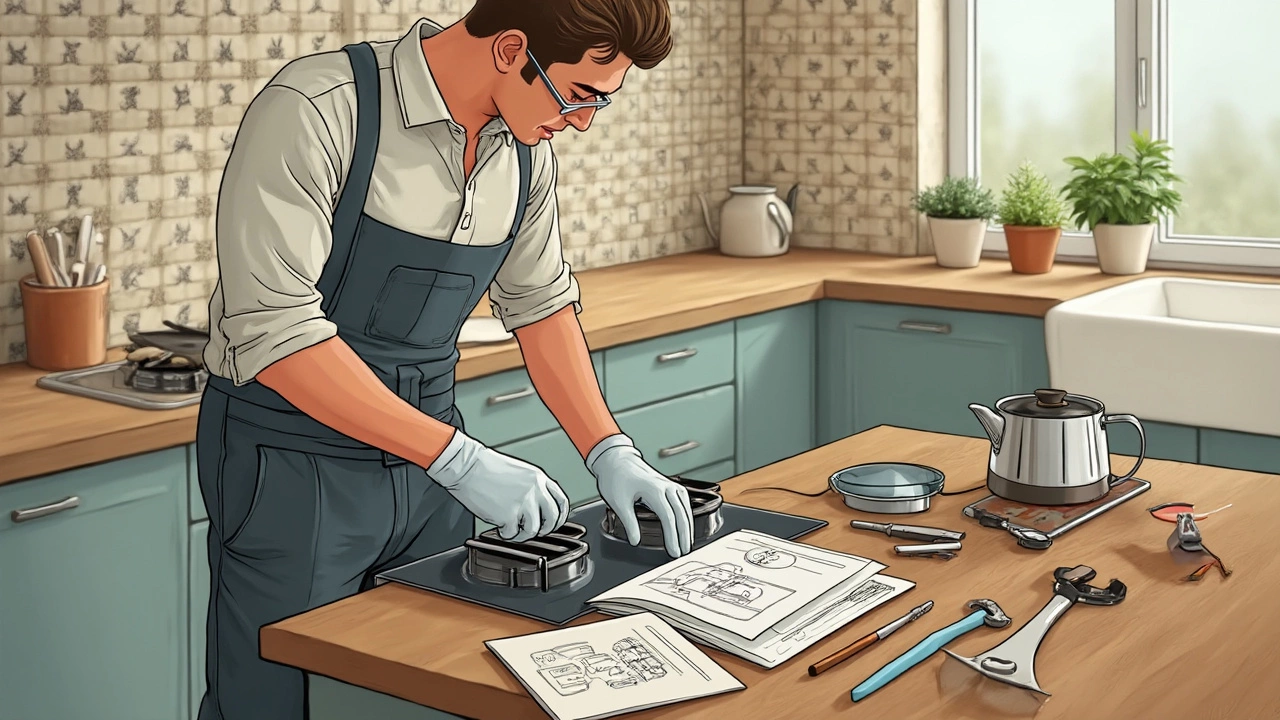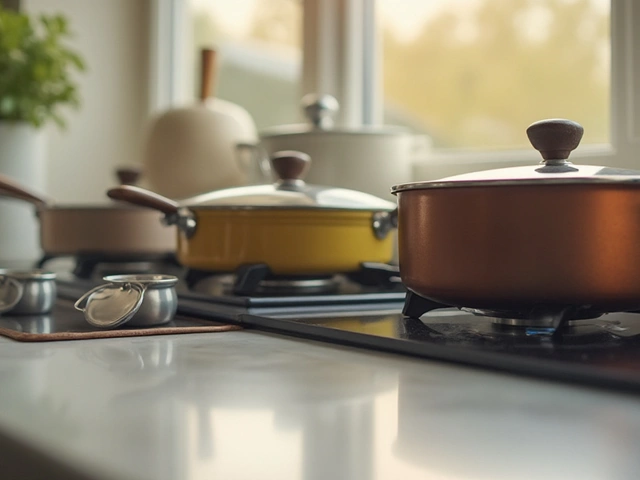Ever heard that breaking the glass top on your hob means the whole thing is toast? Not always true. Glass hobs can look fragile, but not every crack or chip sends them to the junkyard. Knowing what can really be fixed will save you a lot of money and nerves.
If you spot a tiny chip near the corner or a slim hairline crack that doesn’t run across where you cook, don’t freak out just yet. Some small issues don’t automatically mean danger. But, if you see spider-webbing cracks, huge splinters, or any sharp edges—stop using the hob right away. Even a small crack can turn ugly fast if it’s close to a burner or gets too hot.
Before you even think about fixing it, always unplug your hob or turn off the breaker—it’s not worth getting zapped. Most modern glass hobs use toughened glass, made to shatter in a way that’s safer than old-school glass. But trust me, trying to fix structural damage with glue or tape is asking for trouble. There’s a reason repair pros never recommend it.
- Glass Hob Basics: What Usually Breaks?
- Can Small Cracks or Chips Be Fixed?
- When Should You Replace the Glass?
- DIY Hob Repair: What’s Actually Doable?
- Costs and Parts: What Are You Really Paying For?
- When to Call a Professional (and How to Find One)
Glass Hob Basics: What Usually Breaks?
Glass hobs look sleek, but they're not invincible. They're made from toughened glass, which means they're built to handle high temperatures and the weight of most pans. Still, there’s a limit to what they can take. The most common issues? Cracks, scratches, and chips. These usually happen from heavy objects dropping on the glass, sudden temperature changes (like tossing ice on a hot surface), or moving pans too roughly.
Let’s break it down.
- Cracks: These can show up anywhere but usually start at the edges. One big shock or impact, and you might end up with a visible line running part-way or all the way across. If it runs through where the heating element sits, that’s bad news.
- Chips: These are often seen near the front corners or edges—right where you might knock it with a pan. Sometimes, they're small and mostly cosmetic, but deeper chips are a problem.
- Scratches: Over time, grit on the bottom of cookware or cleaning with rough pads can leave visible marks. These won't usually affect performance, but they sure do ruin the clean look.
As for the rest? The electronic touch controls can sometimes stop responding, but that’s usually a whole different problem from glass damage. If the actual glass hob repair is needed, it almost always means you’re dealing with cracks or chips, not just cosmetic marks.
"Damage to ceramic and glass hobs mostly comes from impact or sudden temperature swings. Even though the glass is toughened, repeated stress or a moment’s slip can change things quickly." – Appliance Engineers UK, Service Guide 2024
One tip: If you notice a small chip or hairline crack, don’t ignore it. These spots tend to spread, especially with daily use. Spotting damage early can make a huge difference in your repair options.
Can Small Cracks or Chips Be Fixed?
Spotting a chip or a thin crack on your glass hob can feel like a disaster, but sometimes it’s not as bad as it looks. The trick is figuring out if the damage is mostly cosmetic or if it’s messing with the safety or function of the hob. Most manufacturers, including industry big names like Bosch and Whirlpool, are clear about one thing: any crack that goes deep or spreads near a burner is serious business, and you should stop using the hob right away.
If you see a small chip on the edge—especially away from the heat zones—it usually won’t spread quickly and might not affect cooking. Some folks try a temporary fix with special high-heat epoxy made for glass or ceramic surfaces. Just keep in mind, this is a short-term hack, not a professional repair. It’s sort of like putting a band-aid on a leaky tire. It might buy you a little time, but don’t expect it to last if you cook on that spot often or drop something heavy again.
Here’s what you can (and can’t) fix on a glass hob repair job:
- Small chips on the outer edge: These can sometimes be filled with high-temp epoxy, as long as they’re not sharp or deep.
- Tiny surface scratches: These usually don’t need a repair unless they bug you. There are special scratch removers, but most people just leave them alone.
- Cracks near a burner: Don’t mess around—these are a no-go for DIY. They risk heat getting in and expanding the crack quickly. Replace or call a pro.
- Cracks longer than 3-4 cm or touching an edge: The risk of spreading is way too high, and heat makes it worse. Replacement is the only real option.
If you do try an epoxy fix, follow instructions exactly. Turn off power. Let it cure fully before firing up the hob. And yes, check your warranty first—DIY repairs usually void it. For most cracks and chips, honest answer? A temporary fix can give you a few weeks at best, but for safety and peace of mind, replacement wins every time. No meal’s worth a shattered hob or a trip to the ER.
When Should You Replace the Glass?
This is the part most people don’t want to hear: sometimes, repair isn’t just hard—it’s flat-out unsafe. If the damage makes the glass unsafe or unstable, your only smart move is to get it replaced. So, how do you know when it’s game over for your glass hob?
- Big cracks or chips: If a crack is wide enough to fit a credit card in it, or if there’s a chip missing from the cooking surface, replacement is the only safe choice. Heat makes cracks spread, and dropped food or pans will make things worse fast.
- Cracks crossing heating zones: Any crack that touches or crosses a burner (even a little) means you’re risking shocks and weird heat spots. That’s dangerous for you and your food.
- Multiple cracks or spider-webbing: If your hob starts to look like a car windshield after hail—full of branching cracks—replacement is a no-brainer. This kind of damage ruins the hob’s strength.
- Glass has shattered or pieces have come loose: Stop—don’t use the hob. Shattered glass can’t be repaired or glued safely. Time to call in a pro.
It helps to know that most manufacturers and insurance companies agree on these red lines. And here’s why: toughened glass is strong, but once it’s compromised, it could break further just from everyday use—sometimes explosively. Not worth the risk.
Check out the quick guide below. If your glass looks like any of these, start shopping for a new top:
| Type of Damage | Safe to Repair? | Replace Needed? |
|---|---|---|
| Hairline crack away from burners | Sometimes | No (if stable & monitored) |
| Deep crack crossing a burner | No | Yes |
| Small surface chip (not on burner) | Maybe | No (not spreading) |
| Spider-webbing, shards, loose pieces | No | Yes |
| Discoloration or scorch marks | Not needed | No |
If you’re still unsure, snap a clear photo and send it to a local repair service—they’ll usually tell you right away if repair is pointless. Trust your eyes and your gut. If the glass moves, bows, or feels sharp, don’t risk it. Always put safety over saving a few bucks on your glass hob repair.

DIY Hob Repair: What’s Actually Doable?
Here’s where you might be hoping for a miracle fix. Let’s be straight: when it comes to a glass hob repair, your options for a real DIY job are pretty limited. Most repairs aren’t as easy as slapping on a patch or pouring in some magic filler. But don’t give up just yet—there are a few things you can handle without calling a professional.
If you’ve got minor scratches or stains—not cracks!—you can usually buff these out or clean them yourself. Cooktop cleaner creams (grab them from any supermarket) help remove burnt residue and fine scratches. For chips or actual cracks, though, don’t try to fill them up with glue or silicone—it won’t hold up under heat, and it can even make things dangerous.
What is actually doable as a DIY fix?
- Replace worn or cracked control knobs: These pop off pretty easily, and replacements are cheap.
- Clean or replace seals/gaskets: Damaged rubber gaskets can make the hob unstable. You can find replacement gaskets online and just swap them out.
- Buff out light scratches: Special glass hob cleaning pads can take care of shallow scratches but won’t do anything for deep damage.
If you are thinking of replacing the whole glass panel yourself, be aware: it’s not as simple as unscrewing a lid. You have to disconnect the power fully, keep track of tiny screws, and have just the right replacement part. Most DIYers mess up by not handling the element wires correctly or shattering the new glass during installation. Here’s a risk breakdown based on actual repair data from appliance repair services across the UK for 2024:
| DIY Task | Risk Level | Success Rate for Beginners (%) |
|---|---|---|
| Buff out scratches | Low | 82 |
| Replace control knobs | Low | 94 |
| Replace seals/gaskets | Medium | 76 |
| Replace whole glass panel | High | 17 |
| Repairing cracks/chips with glue | Very High (Not Safe) | 0 |
One last warning: ignoring a serious crack or trying to patch it up almost always leads to more headaches. Glass hobs operate under high heat and power. A dodgy DIY fix is a fire or electric shock waiting to happen. If you’re ever in doubt, spending the money on a professional could easily save you a ton more in the long run.
Costs and Parts: What Are You Really Paying For?
Repairing a glass hob isn’t always cheap, and the sticker shock usually hits when you see the price for the glass itself. Most of what you pay doesn’t even go to the technician—it’s the glass top that drains your wallet. Replacement glass is toughened, heat-resistant, and custom-cut for specific models, so you can’t just slap on any old sheet.
Let’s break down what makes up the total cost:
- Glass hob repair parts — The biggest chunk of your bill is the actual glass top. For a standard four-burner, expect to pay anywhere from £80 to £250 depending on the brand and model. Higher-end brands or unusual sizes? That can hit £300 or even more.
- Labour — Technician rates vary by region and company, but for a simple glass swap, you’re looking at about £60–£120. That usually covers an hour or two of work—removing the old glass, cleaning up debris, and fitting the new piece.
- Call-out or travel fees — Some companies tack on an extra £20–£50 just for coming out, especially if you’re outside city limits.
Here’s a quick table to give you a sense of the real-world costs:
| Part/Labour | Average Cost (UK, 2025) |
|---|---|
| Replacement Glass (Standard, 4-burner) | £80–£250 |
| Replacement Glass (Premium/Custom) | £250–£350 |
| Labour (Install Only) | £60–£120 |
| Call-out Fee | £20–£50 |
It’s worth asking about warranty before paying anything. Some brands, like Bosch or Neff, will cover the part if your appliance is less than two years old, but labour might still cost you. Also, check if your home insurance will help out—a few policies cover accidental damage in the kitchen.
Pro tip: Don’t be tempted by super-cheap replacement glass online unless you’re 100% sure it’s made for your hob. Off-brand or thin glass is more likely to crack again and can mess with how evenly the burners heat up. Always get parts that match your hob’s model number.
When to Call a Professional (and How to Find One)
Sometimes you just shouldn’t mess with a glass hob repair on your own. If you see cracks creeping near a burner, broken glass scattered on the surface, or if bits of the hob wobble or move, don’t risk it. Even if you’re handy, this isn’t the time for duct tape or super glue—those quick fixes won’t hold up to heat and can actually make things more dangerous. Electric shocks and gas leaks are real risks if you take things apart incorrectly.
Got a fancy induction hob? Or one with digital touch controls? Professional help isn’t just recommended—it’s almost required. Modern hobs often need parts that only a certified tech can get, and warranty companies won’t honor DIY repairs. Insurance claims can go south if you have a go yourself and something catches fire.
So, how do you find the right person? Start by checking the manufacturer’s website. Most big brands have lists of approved repair providers. Authorized techs know the ins and outs of your hob model and can get official parts. Another trick is to use trade association sites. In the UK, the Domestic Appliance Service Association (DASA) keeps a database of qualified techs. In the US, look up local appliance repair services with great Google reviews, and check that they’re listed on Better Business Bureau or a similar watchdog site.
Here’s a quick comparison to help:
| When To Call a Pro | DIY Risk Level |
|---|---|
| Cracked all the way through or around burners | High - risk of electric shock, fire, or injury |
| Glass shards on the cooker | High - danger of cuts, further breakage |
| Induction or touch-controlled hob issues | High - complex electrics, warranty may be void |
| Visible wiring, exposed heating elements | Extreme - do not attempt DIY |
When you call, describe the problem clearly. Is it a single crack? Multiple? Are any lights flashing or does the hob give an error code? The more details you give, the faster the tech can help (and sometimes, they’ll tell you if it’s something you can actually do yourself).
- Always ask if the tech is certified for your specific brand.
- Check if repairs come with a guarantee—good pros back their work.
- If your hob is new, check the warranty before paying for anything yourself.
Trying to cut corners on repair costs can end up costing you way more. A proper repair keeps your kitchen safe and your hob running like it should.




